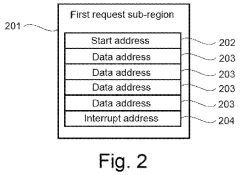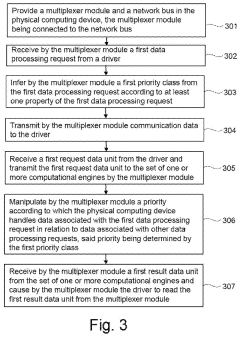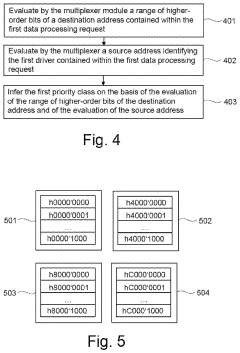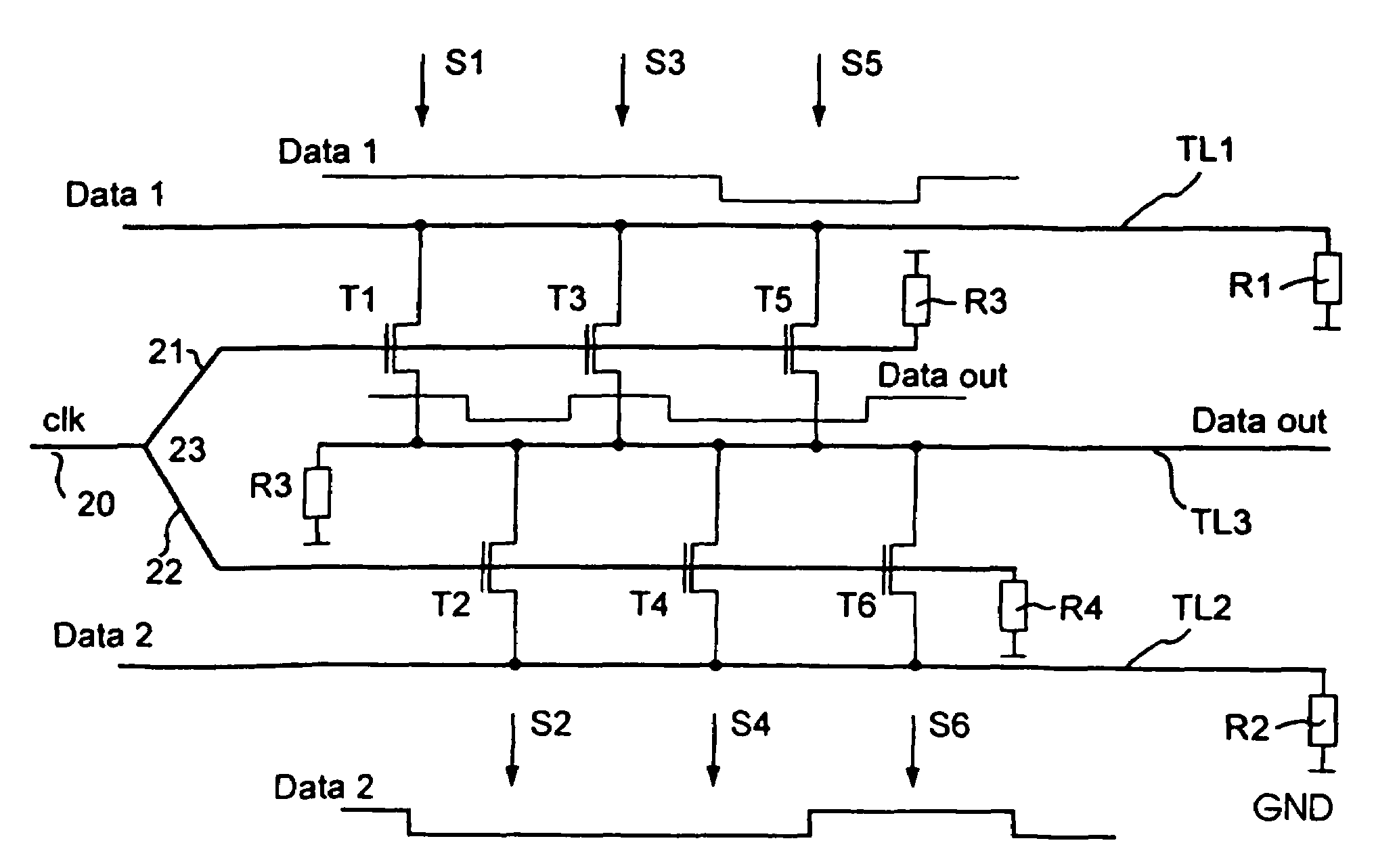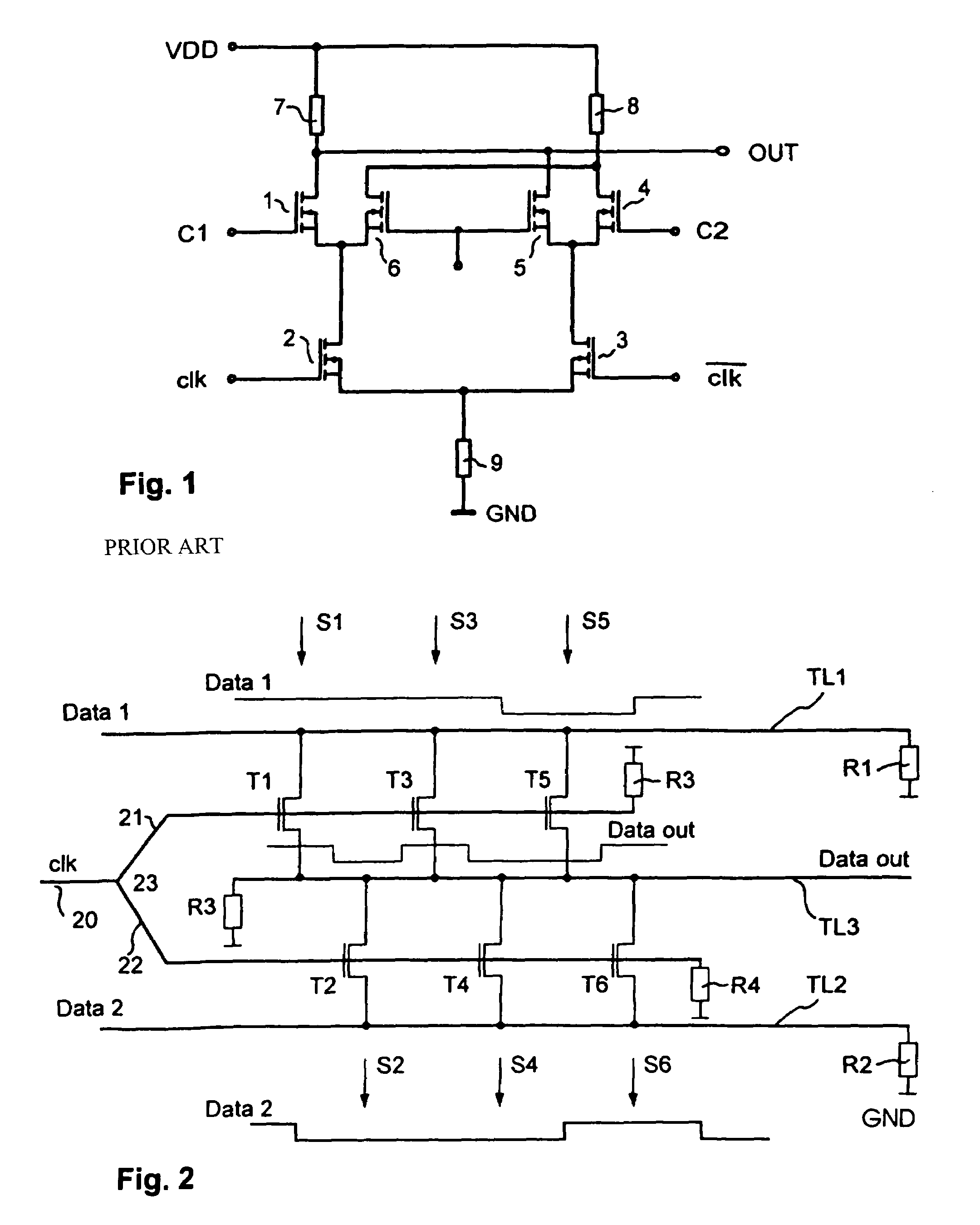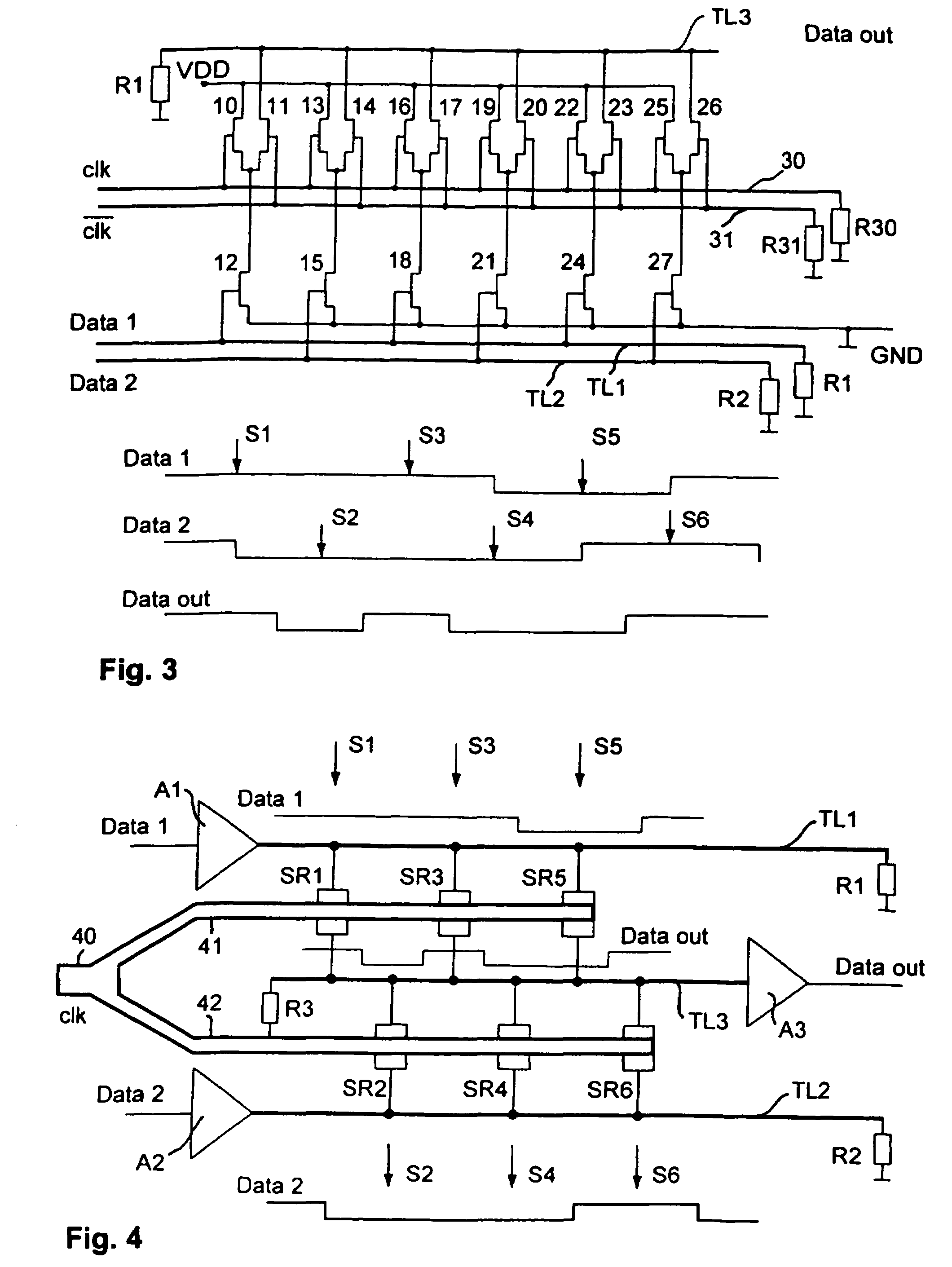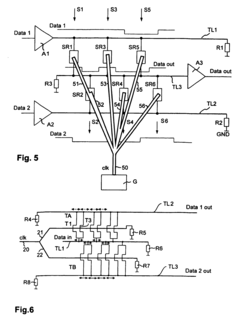How to Define Multiplexer Potential in Expanding Technology Ecosystems?
JUL 13, 20259 MIN READ
Generate Your Research Report Instantly with AI Agent
Patsnap Eureka helps you evaluate technical feasibility & market potential.
Multiplexer Evolution and Objectives
Multiplexers have undergone significant evolution since their inception in the mid-20th century. Initially developed for telecommunications, these devices have become integral components in various technological domains. The evolution of multiplexers has been driven by the increasing demand for efficient data transmission and processing in expanding technology ecosystems.
In the early stages, multiplexers were primarily analog devices used in telephone systems to combine multiple voice signals onto a single transmission line. As digital technology advanced, time-division multiplexing (TDM) emerged, allowing multiple digital signals to share a common channel by allocating time slots to each signal. This marked a crucial milestone in multiplexer development, significantly increasing data transmission capacity.
The advent of wavelength-division multiplexing (WDM) in optical communications revolutionized the field, enabling multiple optical signals to be transmitted simultaneously over a single fiber. This technology has been instrumental in meeting the exponential growth in data traffic driven by the internet and cloud computing.
As technology ecosystems continue to expand, multiplexers are evolving to address new challenges. The Internet of Things (IoT) and 5G networks are pushing the boundaries of data transmission and processing capabilities. In response, multiplexers are being developed with higher channel densities, lower power consumption, and increased flexibility to accommodate diverse data types and protocols.
The primary objective of modern multiplexer development is to enhance the efficiency and capacity of data transmission while maintaining signal integrity. This involves improving spectral efficiency, reducing latency, and increasing the number of channels that can be multiplexed. Additionally, there is a growing focus on developing software-defined multiplexers that can adapt to changing network conditions and requirements in real-time.
Another key objective is to integrate multiplexers with other advanced technologies such as artificial intelligence and edge computing. This integration aims to create intelligent multiplexing systems capable of optimizing data flow, predicting network congestion, and autonomously reconfiguring to maintain optimal performance in complex, dynamic technology ecosystems.
As we look to the future, the potential of multiplexers in expanding technology ecosystems lies in their ability to facilitate seamless connectivity and data management across diverse platforms and applications. The ongoing research and development in this field are focused on creating versatile, high-performance multiplexers that can support the convergence of various technologies, from IoT and 5G to quantum computing and beyond.
In the early stages, multiplexers were primarily analog devices used in telephone systems to combine multiple voice signals onto a single transmission line. As digital technology advanced, time-division multiplexing (TDM) emerged, allowing multiple digital signals to share a common channel by allocating time slots to each signal. This marked a crucial milestone in multiplexer development, significantly increasing data transmission capacity.
The advent of wavelength-division multiplexing (WDM) in optical communications revolutionized the field, enabling multiple optical signals to be transmitted simultaneously over a single fiber. This technology has been instrumental in meeting the exponential growth in data traffic driven by the internet and cloud computing.
As technology ecosystems continue to expand, multiplexers are evolving to address new challenges. The Internet of Things (IoT) and 5G networks are pushing the boundaries of data transmission and processing capabilities. In response, multiplexers are being developed with higher channel densities, lower power consumption, and increased flexibility to accommodate diverse data types and protocols.
The primary objective of modern multiplexer development is to enhance the efficiency and capacity of data transmission while maintaining signal integrity. This involves improving spectral efficiency, reducing latency, and increasing the number of channels that can be multiplexed. Additionally, there is a growing focus on developing software-defined multiplexers that can adapt to changing network conditions and requirements in real-time.
Another key objective is to integrate multiplexers with other advanced technologies such as artificial intelligence and edge computing. This integration aims to create intelligent multiplexing systems capable of optimizing data flow, predicting network congestion, and autonomously reconfiguring to maintain optimal performance in complex, dynamic technology ecosystems.
As we look to the future, the potential of multiplexers in expanding technology ecosystems lies in their ability to facilitate seamless connectivity and data management across diverse platforms and applications. The ongoing research and development in this field are focused on creating versatile, high-performance multiplexers that can support the convergence of various technologies, from IoT and 5G to quantum computing and beyond.
Market Demand Analysis
The market demand for multiplexers in expanding technology ecosystems has been experiencing significant growth, driven by the increasing complexity and interconnectedness of modern technological infrastructures. As data transmission and processing requirements continue to escalate across various industries, the need for efficient signal routing and management solutions has become paramount.
In the telecommunications sector, the proliferation of 5G networks and the ongoing development of 6G technologies have created a surge in demand for high-performance multiplexers. These devices play a crucial role in managing the massive data flows associated with next-generation wireless communications, enabling the simultaneous transmission of multiple signals over a single channel.
The Internet of Things (IoT) has emerged as another major driver of multiplexer demand. As the number of connected devices continues to grow exponentially, the ability to efficiently manage and route data from numerous sources has become essential. Multiplexers are integral to IoT infrastructure, facilitating the seamless integration of diverse sensors, actuators, and communication modules within complex ecosystems.
In the automotive industry, the trend towards connected and autonomous vehicles has led to a significant increase in the demand for multiplexers. These devices are essential for managing the multitude of sensors and communication systems required for advanced driver assistance systems (ADAS) and autonomous driving capabilities. The automotive multiplexer market is expected to grow substantially as vehicle electrification and automation continue to advance.
The data center and cloud computing sectors have also contributed to the rising demand for multiplexers. With the exponential growth in data generation and processing requirements, multiplexers play a vital role in optimizing data flow and reducing latency within these complex infrastructures. The need for high-speed, low-latency data transmission in edge computing applications has further amplified this demand.
In the industrial automation sector, the implementation of Industry 4.0 principles has created new opportunities for multiplexer applications. Smart factories and industrial IoT systems rely on multiplexers to manage the vast array of sensors, actuators, and control systems that enable real-time monitoring and optimization of manufacturing processes.
The healthcare industry has also emerged as a significant market for multiplexers, particularly in the realm of medical imaging and diagnostic equipment. Advanced medical devices often require the simultaneous processing of multiple sensor inputs, making multiplexers essential for ensuring accurate and efficient data management in critical healthcare applications.
As technology ecosystems continue to expand and evolve, the potential applications for multiplexers are likely to grow even further. The increasing convergence of various technologies, such as AI, edge computing, and 5G, will create new challenges and opportunities for signal management and data routing, further driving the demand for innovative multiplexer solutions across diverse industries and applications.
In the telecommunications sector, the proliferation of 5G networks and the ongoing development of 6G technologies have created a surge in demand for high-performance multiplexers. These devices play a crucial role in managing the massive data flows associated with next-generation wireless communications, enabling the simultaneous transmission of multiple signals over a single channel.
The Internet of Things (IoT) has emerged as another major driver of multiplexer demand. As the number of connected devices continues to grow exponentially, the ability to efficiently manage and route data from numerous sources has become essential. Multiplexers are integral to IoT infrastructure, facilitating the seamless integration of diverse sensors, actuators, and communication modules within complex ecosystems.
In the automotive industry, the trend towards connected and autonomous vehicles has led to a significant increase in the demand for multiplexers. These devices are essential for managing the multitude of sensors and communication systems required for advanced driver assistance systems (ADAS) and autonomous driving capabilities. The automotive multiplexer market is expected to grow substantially as vehicle electrification and automation continue to advance.
The data center and cloud computing sectors have also contributed to the rising demand for multiplexers. With the exponential growth in data generation and processing requirements, multiplexers play a vital role in optimizing data flow and reducing latency within these complex infrastructures. The need for high-speed, low-latency data transmission in edge computing applications has further amplified this demand.
In the industrial automation sector, the implementation of Industry 4.0 principles has created new opportunities for multiplexer applications. Smart factories and industrial IoT systems rely on multiplexers to manage the vast array of sensors, actuators, and control systems that enable real-time monitoring and optimization of manufacturing processes.
The healthcare industry has also emerged as a significant market for multiplexers, particularly in the realm of medical imaging and diagnostic equipment. Advanced medical devices often require the simultaneous processing of multiple sensor inputs, making multiplexers essential for ensuring accurate and efficient data management in critical healthcare applications.
As technology ecosystems continue to expand and evolve, the potential applications for multiplexers are likely to grow even further. The increasing convergence of various technologies, such as AI, edge computing, and 5G, will create new challenges and opportunities for signal management and data routing, further driving the demand for innovative multiplexer solutions across diverse industries and applications.
Current Challenges in Multiplexer Technology
Multiplexer technology, while fundamental to modern communication systems, faces several significant challenges in the rapidly expanding technology ecosystems. One of the primary issues is the increasing demand for higher data rates and bandwidth. As the volume of data transmitted through networks continues to grow exponentially, multiplexers are under pressure to handle more channels and higher frequencies without compromising signal integrity or introducing excessive latency.
Another challenge lies in the realm of power consumption and heat dissipation. As multiplexers are integrated into more compact and portable devices, managing power efficiency becomes crucial. The need to balance performance with energy conservation presents a complex engineering problem, particularly in applications where battery life is a critical factor.
Signal interference and crosstalk remain persistent challenges, especially as the density of channels increases. Multiplexers must maintain signal isolation between adjacent channels to prevent data corruption and ensure reliable transmission. This becomes increasingly difficult as the physical size of components shrinks and the proximity between channels narrows.
The integration of multiplexers with emerging technologies, such as 5G networks and Internet of Things (IoT) devices, presents new challenges. These applications often require multiplexers to operate across a wider range of frequencies and environmental conditions, pushing the boundaries of current designs and materials.
Scalability and flexibility are also key concerns. As technology ecosystems evolve, multiplexers need to adapt to changing standards and protocols. Designing multiplexers that can be easily upgraded or reconfigured without requiring complete system overhauls is a significant challenge for manufacturers.
Cost-effectiveness remains a persistent issue, particularly in consumer electronics and large-scale network infrastructure. Balancing the need for advanced features and performance with competitive pricing pressures the industry to innovate in both design and manufacturing processes.
Lastly, the challenge of miniaturization continues to drive research and development. As devices become smaller and more integrated, multiplexers must follow suit without sacrificing functionality. This miniaturization effort often conflicts with other requirements such as heat dissipation and signal integrity, creating a complex set of trade-offs for engineers to navigate.
Another challenge lies in the realm of power consumption and heat dissipation. As multiplexers are integrated into more compact and portable devices, managing power efficiency becomes crucial. The need to balance performance with energy conservation presents a complex engineering problem, particularly in applications where battery life is a critical factor.
Signal interference and crosstalk remain persistent challenges, especially as the density of channels increases. Multiplexers must maintain signal isolation between adjacent channels to prevent data corruption and ensure reliable transmission. This becomes increasingly difficult as the physical size of components shrinks and the proximity between channels narrows.
The integration of multiplexers with emerging technologies, such as 5G networks and Internet of Things (IoT) devices, presents new challenges. These applications often require multiplexers to operate across a wider range of frequencies and environmental conditions, pushing the boundaries of current designs and materials.
Scalability and flexibility are also key concerns. As technology ecosystems evolve, multiplexers need to adapt to changing standards and protocols. Designing multiplexers that can be easily upgraded or reconfigured without requiring complete system overhauls is a significant challenge for manufacturers.
Cost-effectiveness remains a persistent issue, particularly in consumer electronics and large-scale network infrastructure. Balancing the need for advanced features and performance with competitive pricing pressures the industry to innovate in both design and manufacturing processes.
Lastly, the challenge of miniaturization continues to drive research and development. As devices become smaller and more integrated, multiplexers must follow suit without sacrificing functionality. This miniaturization effort often conflicts with other requirements such as heat dissipation and signal integrity, creating a complex set of trade-offs for engineers to navigate.
Existing Multiplexer Solutions
01 High-speed multiplexer design
Advanced multiplexer designs focus on improving speed and performance. These designs often incorporate techniques such as parallel processing, pipelining, and optimized signal routing to reduce propagation delays and increase throughput. High-speed multiplexers are crucial in applications like data communications, signal processing, and high-performance computing.- High-speed multiplexer design: Advanced multiplexer designs focus on improving speed and performance. These designs often incorporate techniques such as parallel processing, pipelining, and optimized signal routing to minimize propagation delays and increase data throughput. High-speed multiplexers are crucial in applications like telecommunications, data centers, and high-performance computing.
- Power-efficient multiplexer architectures: Energy-efficient multiplexer designs aim to reduce power consumption while maintaining performance. These architectures may employ techniques such as dynamic power gating, low-voltage operation, and adaptive clock management. Power-efficient multiplexers are particularly important in battery-operated devices and large-scale integrated circuits.
- Reconfigurable and programmable multiplexers: Flexible multiplexer designs allow for dynamic reconfiguration and programmability. These multiplexers can adapt their functionality based on system requirements, enabling versatile and adaptable circuit designs. Reconfigurable multiplexers are valuable in applications such as software-defined radio, adaptive signal processing, and field-programmable gate arrays (FPGAs).
- Optical multiplexing techniques: Optical multiplexers leverage photonic technologies to combine multiple optical signals onto a single fiber or waveguide. These devices enable high-bandwidth data transmission in fiber-optic networks and photonic integrated circuits. Optical multiplexing techniques include wavelength division multiplexing (WDM) and time division multiplexing (TDM) for efficient use of optical communication channels.
- Fault-tolerant multiplexer designs: Robust multiplexer architectures incorporate fault-tolerance mechanisms to ensure reliable operation in the presence of errors or failures. These designs may include redundancy, error detection and correction, and self-healing capabilities. Fault-tolerant multiplexers are essential in critical applications such as aerospace, automotive, and industrial control systems.
02 Power-efficient multiplexer architectures
Energy-efficient multiplexer designs aim to reduce power consumption while maintaining performance. These architectures may employ techniques such as dynamic power management, low-voltage operation, and optimized transistor sizing. Power-efficient multiplexers are particularly important in battery-operated devices and large-scale integrated circuits.Expand Specific Solutions03 Multiplexers in optical communication systems
Multiplexers play a crucial role in optical communication systems by combining multiple optical signals onto a single fiber. These specialized multiplexers often use wavelength division multiplexing (WDM) techniques to increase bandwidth and transmission capacity. Advancements in this area focus on improving spectral efficiency and reducing signal interference.Expand Specific Solutions04 Reconfigurable and programmable multiplexers
Reconfigurable multiplexers offer flexibility in signal routing and processing. These designs often incorporate programmable logic elements or software-defined architectures, allowing for dynamic adaptation to changing requirements. Such multiplexers are valuable in applications like software-defined radio, adaptive signal processing, and reconfigurable computing platforms.Expand Specific Solutions05 Multiplexers for analog and mixed-signal applications
Specialized multiplexer designs cater to analog and mixed-signal applications, addressing challenges such as signal integrity, noise reduction, and bandwidth limitations. These multiplexers often incorporate techniques like switched-capacitor circuits, current-mode operation, or differential signaling to improve performance in analog domains.Expand Specific Solutions
Key Industry Players
The multiplexer technology landscape is evolving rapidly within expanding technology ecosystems, characterized by intense competition and significant market potential. The industry is in a growth phase, with increasing demand for multiplexing solutions across various sectors, including telecommunications, data centers, and consumer electronics. Market size is projected to expand substantially, driven by the proliferation of connected devices and the need for efficient data transmission. Technologically, multiplexer solutions are advancing, with companies like Huawei, Ericsson, and Qualcomm leading innovation. These firms, along with Intel and NXP Semiconductors, are investing heavily in R&D to develop more sophisticated, energy-efficient, and high-performance multiplexing technologies, indicating a maturing but still dynamic technological landscape.
Huawei Technologies Co., Ltd.
Technical Solution: Huawei's approach to defining multiplexer potential in expanding technology ecosystems focuses on their innovative 5G and beyond technologies. They have developed advanced multiplexing techniques such as Massive MIMO (Multiple-Input Multiple-Output) and NOMA (Non-Orthogonal Multiple Access) to maximize spectrum efficiency[1]. Their solution includes intelligent network slicing, which allows for dynamic allocation of network resources based on specific use case requirements[2]. Huawei's multiplexer technology also incorporates AI-driven predictive algorithms to optimize resource allocation in real-time, ensuring seamless connectivity across diverse IoT devices and applications[3].
Strengths: Strong R&D capabilities, leading position in 5G technology, and extensive experience in network infrastructure. Weaknesses: Geopolitical challenges affecting global market access and potential supply chain disruptions.
QUALCOMM, Inc.
Technical Solution: Qualcomm's approach to multiplexer potential in expanding technology ecosystems centers around their 5G modem-RF systems and heterogeneous computing solutions. Their multiplexing strategy incorporates advanced carrier aggregation techniques, allowing devices to simultaneously use multiple frequency bands for improved data rates and network capacity[4]. Qualcomm's solution also includes their proprietary Dynamic Spectrum Sharing (DSS) technology, enabling seamless coexistence of 4G and 5G networks on the same spectrum[5]. Additionally, their AI-enhanced signal processing algorithms optimize multiplexing performance in challenging network conditions, ensuring reliable connectivity across diverse IoT applications[6].
Strengths: Industry-leading modem technology, strong patent portfolio, and extensive ecosystem partnerships. Weaknesses: Dependence on smartphone market fluctuations and increasing competition in the 5G chip market.
Core Multiplexer Innovations
Priority-arbitrated access to a set of one or more computational engines
PatentActiveUS20210314185A1
Innovation
- A method and system that utilize a multiplexer module connected to a network bus to infer priority classes from data processing requests, manipulate priorities, and manage access to computational engines, allowing for priority-arbitrated data processing and conflict resolution through logical buffers and virtual channels.
Multiplexer and demultiplexer
PatentInactiveUS7088170B2
Innovation
- A distributed multiplexer design with phase-shifted control signals and optically controlled switching elements, such as low temperature grown GaAs photo resistors, allows for higher switching rates by ensuring equal phase velocities on data and control lines, reducing signal reflections and interference.
Ecosystem Integration Strategies
In the context of expanding technology ecosystems, defining multiplexer potential requires a comprehensive approach to ecosystem integration strategies. These strategies focus on seamlessly incorporating multiplexers into broader technological frameworks, maximizing their value and functionality across diverse applications.
A key aspect of ecosystem integration involves standardization efforts. By establishing common protocols and interfaces, multiplexers can more easily interact with various components within the ecosystem. This standardization facilitates interoperability, allowing for smoother data flow and communication between different devices and systems. Industry collaborations and consortia play a crucial role in developing these standards, ensuring widespread adoption and compatibility.
Another critical strategy is the development of modular architectures. This approach allows for flexible integration of multiplexers into existing systems, as well as easy upgrades and replacements as technology evolves. Modular designs enable customization to meet specific ecosystem requirements while maintaining overall system integrity. This flexibility is particularly important in rapidly changing technological landscapes, where adaptability is key to long-term success.
API development and open-source initiatives form another pillar of effective ecosystem integration. By providing well-documented APIs, multiplexer manufacturers can encourage third-party developers to create innovative applications and services that leverage multiplexer capabilities. Open-source projects can further accelerate integration by fostering community-driven development and problem-solving.
Cloud integration strategies are becoming increasingly important as ecosystems expand into distributed and edge computing environments. Multiplexers that can seamlessly connect to cloud platforms enable more efficient data processing, storage, and analysis. This integration allows for scalable solutions that can adapt to varying workloads and provide real-time insights across the ecosystem.
Security and privacy considerations must be at the forefront of integration strategies. As multiplexers often handle sensitive data and control critical functions, robust security protocols and encryption methods are essential. Implementing end-to-end security measures and adhering to industry-specific compliance standards ensures that multiplexers can be trusted components within larger ecosystems.
Lastly, ecosystem integration strategies should include comprehensive testing and validation processes. These processes ensure that multiplexers function correctly within diverse ecosystem configurations and under various operating conditions. Rigorous testing helps identify potential issues early in the integration process, reducing the risk of system failures and improving overall reliability.
A key aspect of ecosystem integration involves standardization efforts. By establishing common protocols and interfaces, multiplexers can more easily interact with various components within the ecosystem. This standardization facilitates interoperability, allowing for smoother data flow and communication between different devices and systems. Industry collaborations and consortia play a crucial role in developing these standards, ensuring widespread adoption and compatibility.
Another critical strategy is the development of modular architectures. This approach allows for flexible integration of multiplexers into existing systems, as well as easy upgrades and replacements as technology evolves. Modular designs enable customization to meet specific ecosystem requirements while maintaining overall system integrity. This flexibility is particularly important in rapidly changing technological landscapes, where adaptability is key to long-term success.
API development and open-source initiatives form another pillar of effective ecosystem integration. By providing well-documented APIs, multiplexer manufacturers can encourage third-party developers to create innovative applications and services that leverage multiplexer capabilities. Open-source projects can further accelerate integration by fostering community-driven development and problem-solving.
Cloud integration strategies are becoming increasingly important as ecosystems expand into distributed and edge computing environments. Multiplexers that can seamlessly connect to cloud platforms enable more efficient data processing, storage, and analysis. This integration allows for scalable solutions that can adapt to varying workloads and provide real-time insights across the ecosystem.
Security and privacy considerations must be at the forefront of integration strategies. As multiplexers often handle sensitive data and control critical functions, robust security protocols and encryption methods are essential. Implementing end-to-end security measures and adhering to industry-specific compliance standards ensures that multiplexers can be trusted components within larger ecosystems.
Lastly, ecosystem integration strategies should include comprehensive testing and validation processes. These processes ensure that multiplexers function correctly within diverse ecosystem configurations and under various operating conditions. Rigorous testing helps identify potential issues early in the integration process, reducing the risk of system failures and improving overall reliability.
Scalability and Performance Metrics
In the context of expanding technology ecosystems, defining multiplexer potential requires a comprehensive evaluation of scalability and performance metrics. These metrics serve as crucial indicators of a multiplexer's capacity to adapt and thrive in increasingly complex and interconnected technological environments.
Scalability, a fundamental aspect of multiplexer potential, refers to the system's ability to handle growing amounts of work or its potential to be enlarged to accommodate that growth. In the realm of multiplexers, this translates to the capacity to manage an increasing number of input signals and output channels without compromising performance or efficiency. Key scalability metrics include input-to-output ratio expansion capabilities, signal processing speed, and the ability to integrate with diverse technological platforms.
Performance metrics, on the other hand, focus on the quantitative assessment of a multiplexer's operational efficiency and effectiveness. These metrics encompass a wide range of parameters, including signal integrity, bandwidth utilization, latency, and power consumption. Signal-to-noise ratio (SNR) is a critical performance indicator, measuring the multiplexer's ability to maintain signal quality amidst increasing complexity. Additionally, throughput, measured in bits per second, provides insight into the system's data processing capabilities.
In expanding technology ecosystems, the interplay between scalability and performance becomes increasingly significant. As the number of connected devices and data streams grows exponentially, multiplexers must demonstrate the ability to scale horizontally (adding more units) and vertically (enhancing the capabilities of existing units) while maintaining or improving performance metrics. This balance is crucial for ensuring that the multiplexer remains a viable and efficient component within evolving technological landscapes.
Another important consideration is the multiplexer's adaptability to different communication protocols and data formats. In diverse ecosystems, the ability to seamlessly interface with various technologies and standards is paramount. Metrics such as protocol compatibility range and data format conversion efficiency become key indicators of a multiplexer's potential in these expanding environments.
Energy efficiency emerges as a critical metric at the intersection of scalability and performance. As systems scale, power consumption can become a limiting factor. Therefore, metrics like power efficiency ratio (performance per watt) and heat dissipation characteristics are essential in evaluating a multiplexer's long-term viability and cost-effectiveness in large-scale deployments.
Reliability and fault tolerance also play crucial roles in defining multiplexer potential. In complex ecosystems, the ability to maintain performance levels under varying conditions and to gracefully handle failures becomes increasingly important. Metrics such as mean time between failures (MTBF), error correction capabilities, and redundancy effectiveness provide valuable insights into the multiplexer's robustness and reliability in demanding, large-scale environments.
Scalability, a fundamental aspect of multiplexer potential, refers to the system's ability to handle growing amounts of work or its potential to be enlarged to accommodate that growth. In the realm of multiplexers, this translates to the capacity to manage an increasing number of input signals and output channels without compromising performance or efficiency. Key scalability metrics include input-to-output ratio expansion capabilities, signal processing speed, and the ability to integrate with diverse technological platforms.
Performance metrics, on the other hand, focus on the quantitative assessment of a multiplexer's operational efficiency and effectiveness. These metrics encompass a wide range of parameters, including signal integrity, bandwidth utilization, latency, and power consumption. Signal-to-noise ratio (SNR) is a critical performance indicator, measuring the multiplexer's ability to maintain signal quality amidst increasing complexity. Additionally, throughput, measured in bits per second, provides insight into the system's data processing capabilities.
In expanding technology ecosystems, the interplay between scalability and performance becomes increasingly significant. As the number of connected devices and data streams grows exponentially, multiplexers must demonstrate the ability to scale horizontally (adding more units) and vertically (enhancing the capabilities of existing units) while maintaining or improving performance metrics. This balance is crucial for ensuring that the multiplexer remains a viable and efficient component within evolving technological landscapes.
Another important consideration is the multiplexer's adaptability to different communication protocols and data formats. In diverse ecosystems, the ability to seamlessly interface with various technologies and standards is paramount. Metrics such as protocol compatibility range and data format conversion efficiency become key indicators of a multiplexer's potential in these expanding environments.
Energy efficiency emerges as a critical metric at the intersection of scalability and performance. As systems scale, power consumption can become a limiting factor. Therefore, metrics like power efficiency ratio (performance per watt) and heat dissipation characteristics are essential in evaluating a multiplexer's long-term viability and cost-effectiveness in large-scale deployments.
Reliability and fault tolerance also play crucial roles in defining multiplexer potential. In complex ecosystems, the ability to maintain performance levels under varying conditions and to gracefully handle failures becomes increasingly important. Metrics such as mean time between failures (MTBF), error correction capabilities, and redundancy effectiveness provide valuable insights into the multiplexer's robustness and reliability in demanding, large-scale environments.
Unlock deeper insights with Patsnap Eureka Quick Research — get a full tech report to explore trends and direct your research. Try now!
Generate Your Research Report Instantly with AI Agent
Supercharge your innovation with Patsnap Eureka AI Agent Platform!

